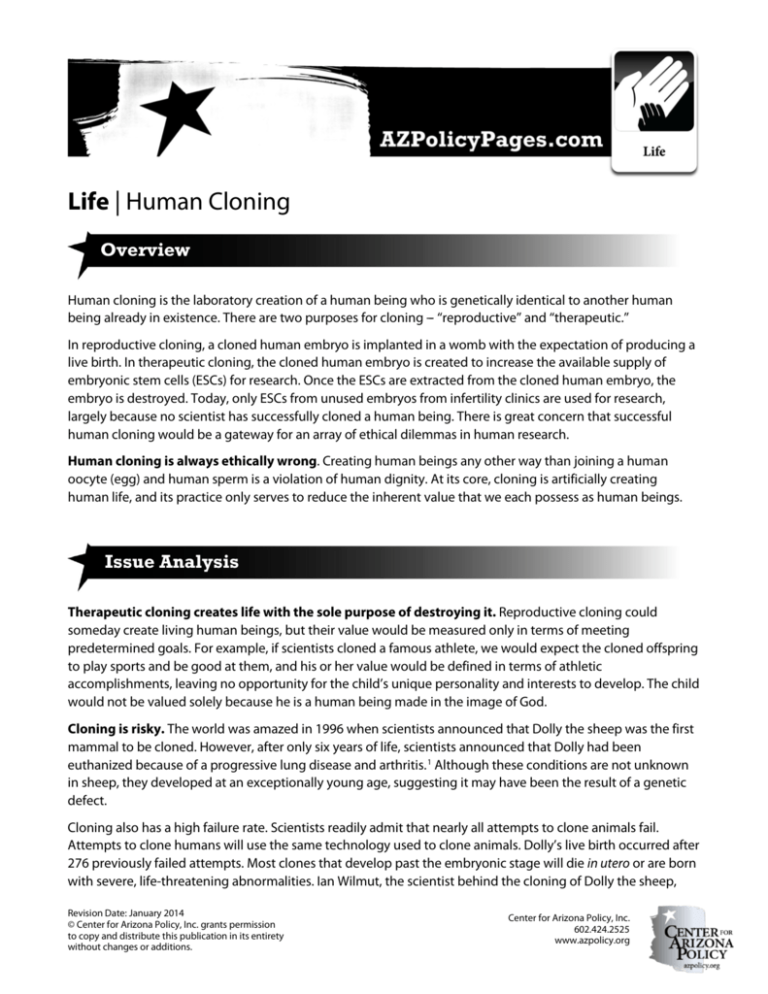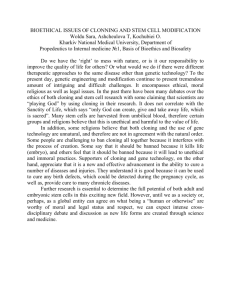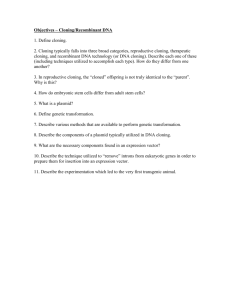
Life | Human Cloning
Overview
Human cloning is the laboratory creation of a human being who is genetically identical to another human
being already in existence. There are two purposes for cloning --- ‘‘reproductive’’ and ‘‘therapeutic.’’
In reproductive cloning, a cloned human embryo is implanted in a womb with the expectation of producing a
live birth. In therapeutic cloning, the cloned human embryo is created to increase the available supply of
embryonic stem cells (ESCs) for research. Once the ESCs are extracted from the cloned human embryo, the
embryo is destroyed. Today, only ESCs from unused embryos from infertility clinics are used for research,
largely because no scientist has successfully cloned a human being. There is great concern that successful
human cloning would be a gateway for an array of ethical dilemmas in human research.
Human cloning is always ethically wrong. Creating human beings any other way than joining a human
oocyte (egg) and human sperm is a violation of human dignity. At its core, cloning is artificially creating
human life, and its practice only serves to reduce the inherent value that we each possess as human beings.
Issue Analysis
Therapeutic cloning creates life with the sole purpose of destroying it. Reproductive cloning could
someday create living human beings, but their value would be measured only in terms of meeting
predetermined goals. For example, if scientists cloned a famous athlete, we would expect the cloned offspring
to play sports and be good at them, and his or her value would be defined in terms of athletic
accomplishments, leaving no opportunity for the child’s unique personality and interests to develop. The child
would not be valued solely because he is a human being made in the image of God.
Cloning is risky. The world was amazed in 1996 when scientists announced that Dolly the sheep was the first
mammal to be cloned. However, after only six years of life, scientists announced that Dolly had been
euthanized because of a progressive lung disease and arthritis. 1 Although these conditions are not unknown
in sheep, they developed at an exceptionally young age, suggesting it may have been the result of a genetic
defect.
Cloning also has a high failure rate. Scientists readily admit that nearly all attempts to clone animals fail.
Attempts to clone humans will use the same technology used to clone animals. Dolly’s live birth occurred after
276 previously failed attempts. Most clones that develop past the embryonic stage will die in utero or are born
with severe, life-threatening abnormalities. Ian Wilmut, the scientist behind the cloning of Dolly the sheep,
Revision Date: January 2014
© Center for Arizona Policy, Inc. grants permission
to copy and distribute this publication in its entirety
without changes or additions.
Center for Arizona Policy, Inc.
602.424.2525
www.azpolicy.org
Life | Human Cloning
strongly opposes human cloning. He estimates that an attempt to clone a human would mean obtaining
around 300 human eggs 2 and persuading 29 women to have embryos implanted. 3 Of those, 28 would face
failed pregnancies, miscarriages, and deformed children, all for the goal of achieving one ‘‘healthy’’ child at
birth. 4 Dr. Wilmut concludes that human cloning would be an ‘‘intolerable exercise in human misery and
suffering,’’ and that the costs of even attempting human cloning far outweigh the benefits.
In recent years, the scientific advancements have become more frequent. In January 2008, a San Diego
biotech firm, Stemagen, announced that they were able to clone a human being by inserting DNA from the
skin cells of an adult male into a donated egg cell. 5 In July 2011, scientists in the UK announced that they had
created more than 150 human-animal hybrids using cloning techniques. 6 In October 2011, researchers in New
York announced that they had used cloning to create human embryos with 69 chromosomes, instead of the
normal 46, and that these embryos were the first step to creating new embryonic stem cell lines for research. 7
In 2013, scientists at Oregon Health and Science University announced the successful creation of cloned
human embryos to be used for their stem cells. 8 The stated goal is to use a cloned human's stem cells as a
perfect genetic match to treat that person for diseases --- treatment that can already be accomplished using
ethical adult cells that are reprogrammed (known as induced pluripotent stem cells or "iPS") --- and the
scientists are currently comparing the effectiveness of the cloned stem cells to the iPS cells. 9
Currently, there is no federal ban on human cloning, although federal funds from the National Institutes of
Health cannot be used for research that creates or destroys human embryos, as cloning does. 10 Without a
national or international ban, the states are left to enact specific laws that hold researchers to ethical
standards. Human cloning has proven to be a risky and unnecessary enterprise and the advances in
biotechnology during the last decade have removed any need for scientists to engage in the practice.
State Responses to Cloning
To date, eight states ban human cloning for any reason, and ten states ban cloning for reproductive
purposes. 11 On the other hand, seven states allow the use of taxpayer dollars to fund human cloning and other
destructive research on human embryos. 12 Two of those states have authorized and poured billions of dollars
into this ethically troubling field. 13
Arizona Law
In 2005, Arizona enacted a Center for Arizona Policy (CAP)-supported law that banned public funding for
human cloning and cloning research. 14
In 2010, Arizona took additional steps to avoid the dire ethical and moral dilemmas of human cloning. Thanks
to a CAP-supported law, Arizona now bans human cloning outright, prohibits the purchase of human eggs for
research purposes, prohibits destructive embryonic stem cell research, prohibits the sale of human embryos,
and bans the creation of human-animal hybrids. 15
Revision Date: January 2014
© Center for Arizona Policy, Inc. grants permission
to copy and distribute this publication in its entirety
without changes or additions.
Center for Arizona Policy, Inc.
602.424.2525
www.azpolicy.org
Life | Human Cloning
Talking Points
•
Human cloning is always morally wrong. Creating human beings any other way than joining a
human oocyte (egg) and human sperm is a violation of human dignity.
•
Cloning for the purpose of destruction and experimentation devalues human life. A willingness
to destroy life to preserve the health of another violates the most basic principles of civilized society.
•
Cloning has a high failure rate. Even the scientist behind the cloning of Dolly the sheep has since
changed his stance on the issue because of the high rate of failure and many ethical problems with
the process.
Conclusion
Human cloning is unnecessary and unjustifiable. It takes a utilitarian view of human embryos, viewing them
not as people, but as a commodity. Allowing therapeutic cloning technology to be perfected could also lead
to illicit future reproductive cloning activities because stored in vitro embryos would be indistinguishable from
stored cloned human embryos.
© January 2014 Center for Arizona Policy, Inc. All rights reserved.
This publication includes summaries of many complex areas of law and is not specific legal advice to any person. Consult an attorney if you
have questions about your specific situation or believe your legal rights have been infringed. This publication is educational in nature
and should not be construed as an effort to aid or hinder any legislation.
1
Prematurely old, ill, Dolly euthanized, St. Petersburg Times, Feb. 15, 2003, available at
www.sptimes.com/2003/02/15/Worldandnation/Prematurely_old__ill_.shtml.
2
For more on the dangers of human egg donation, visit www.eggsploitation.com.
3
Ian Wilmut, Cloning, New Scientist, October 2010, available at
www.newscientist.com/data/doc/teaser/mm/201010/instant_expert_2_-_cloning.pdf.
4
Id.
5
Terri Somers, Successful embryo cloning documented, San Diego Union-Tribune, Jan. 17, 2008, available at
www.signonsandiego.com/uniontrib/20080117/news_1n17embryo.html.
6
Daniel Martin, 150 human animal hybrids grown in UK labs: Embryos have been produced secretively for the past three years, Mail Online,
July 25, 2011, www.dailymail.co.uk/sciencetech/article-2017818/Embryos-involving-genes-animals-mixed-humans-producedsecretively-past-years.html (last visited Sept. 20, 2013).
7
Brian Alexander, Report: Stem Cells Created from Cloned Human Embryos, Health Care on MSNBC.com, Oct. 5, 2011,
www.msnbc.msn.com/id/44788564/ns/health-health_care/#.TqBZC3K0KSo (last visited Sept. 20, 2013).
8
David Cyranoski, Human Stem Cells Created by Cloning, 497 Nature 295 (2013), available at www.nature.com/news/human-stemcells-created-by-cloning-1.12983.
9
Id.
Revision Date: January 2014
© Center for Arizona Policy, Inc. grants permission
to copy and distribute this publication in its entirety
without changes or additions.
Center for Arizona Policy, Inc.
602.424.2525
www.azpolicy.org
Life | Human Cloning
National Institutes for Health Grants Policy Statement, Public Policy Requirements, Objectives and Other Appropriation Mandates,
Section 4.2.4 (2011), http://grants.nih.gov/grants/policy/nihgps_2011/nihgps_ch4.htm#human_embryo_research_cloning_ban (last
visited Sept. 20, 2013).
11
Eight states that ban cloning for any purpose are: AR, AZ, IN, MI, ND, OK, and SD. Ten states that ban reproductive cloning only are:
CA, CT, IL, IA, MA, MD, MO, MT, NJ, and RI. See Americans United for Life, Laws Related to Human Cloning, Defending Life 2012, 2012,
available at www.aul.org/wp-content/uploads/2012/04/bioethics-maps.pdf.
12
Id.
13
California and New Jersey. See, e.g., Human Cloning Laws, Nat’l Conf. of State Legis., January 2008,
www.ncsl.org/default.aspx?tabid=14284 (last visited Sept. 20, 2013); David W. Chen, New Jersey Lawmakers Pass Stem-Cell Bill, N.Y.
Times, Dec. 14, 2006, available at http://www.nytimes.com/2006/12/14/nyregion/14cnd-jersey.html; Carl T. Hall, State Voters Strongly
Backing Cell Research, S.F. Chronicle, Nov. 3, 2004, available at http://articles.sfgate.com/2004-11-03/bay-area/17454419_1_stem-cellcalifornia-stem-cell-research-gold-rush.
14
Ariz. Rev. Stat. § 35-196.04.
15
Ariz. Rev. Stat. §§ 36-2311 through 2313 and § 36-1703 (purchase of human eggs for research prohibited).
10
Revision Date: January 2014
© Center for Arizona Policy, Inc. grants permission
to copy and distribute this publication in its entirety
without changes or additions.
Center for Arizona Policy, Inc.
602.424.2525
www.azpolicy.org








